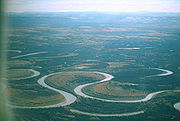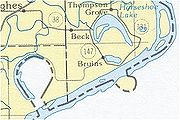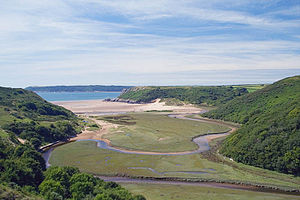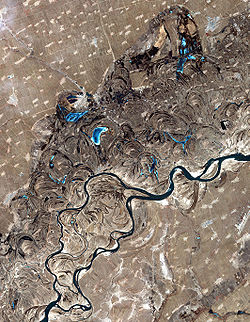
Oxbow lake
Background Information
SOS Children offer a complete download of this selection for schools for use on schools intranets. Click here to find out about child sponsorship.
An oxbow lake is a U-shaped lake water body formed when a wide meander from the mainstem of a river is cut off to create a lake. This landform is called an oxbow lake for the distinctive curved shape that results from this process. In Australia, an oxbow lake is called a billabong. By itself, the word oxbow can also mean a U-shaped bend in a river or stream, whether or not it is cut off from the mainstream.

Formation
When a river reaches a low-lying plain, often in its final course to the sea or a lake, it meanders widely. In the vicinity of a river bend, deposition occurs on the convex bank (the bank with the smaller radius). In contrast, both lateral erosion and undercutting occur on the cut bank or concave bank (the bank with the greater radius.) Continuous deposition on the convex bank and erosion of the concave bank of a meandering river cause the formation of a very pronounced meander with two concave banks getting closer. The narrow neck of land between the two neighbouring concave banks is finally cut through, either by lateral erosion of the two concave banks or by the strong currents of a flood. When this happens, a new straighter river channel is created and an abandoned meander loop, called a cut-off, is formed. When deposition finally seals off the cut-off from the river channel, an oxbow lake is formed. This process can occur over a time scale from a few years to several decades and may sometimes become essentially static.
Gathering of erosion products near the concave bank and transporting them to the convex bank is the work of the secondary flow across the floor of the river in the vicinity of a river bend. The process of deposition of silt, sand and gravel on the convex bank is clearly illustrated in point bars.
It is instructive to demonstrate the effect of the secondary flow using a circular bowl. Partly fill the bowl with water and sprinkle dense particles such as sand or rice into the bowl. Set the water into circular motion with one hand or a spoon. The dense particles will quickly be swept into a neat pile in the centre of the bowl. This is the mechanism that leads to the formation of point bars and contributes to the formation of oxbow lakes. The primary flow of water in the bowl is circular and the streamlines are concentric with the side of the bowl. However, the secondary flow of the boundary layer across the floor of the bowl is inward toward the center. The primary flow might be expected to fling the dense particles to the perimeter of the bowl, but instead the secondary flow sweeps the particles toward the centre.
The curved path of a river around a bend causes the surface of the water to be slightly higher on the outside of the river bend than on the inside. As a result, at any elevation within the river the water pressure is slightly greater near the outside of the river bend than on the inside. There is a pressure gradient toward the convex bank which provides the centripetal force necessary for each parcel of water to follow its curved path. The boundary layer flowing along the floor of the river is not moving fast enough to balance the pressure gradient laterally across the river. It responds to this pressure gradient and its velocity is partly downstream and partly across the river toward the convex bank. As it flows along the floor of the river it sweeps loose material toward the convex bank. This flow of the boundary layer is significantly different from the speed and direction of the primary flow of the river, and is part of the river's secondary flow.
When a fluid follows a curved path, such as around a circular bowl, around a bend in a river or in a tropical cyclone, the flow is described as vortex flow – the fastest speed occurs where the radius is smallest, and the slowest speed occurs where the radius is greatest. The higher fluid pressure and slower speed where the radius is greater, and the lower pressure and faster speed where the radius is smaller, are all consistent with Bernoulli's principle.

The bulges in the border reflect changes in the course of the river; when the river shifted its course and cut off the former channel, the border did not change.
Examples

The Reelfoot Lake in west Tennessee is an oxbow lake formed when the Mississippi River changed course following the New Madrid Earthquake of 1811–1812. There are many oxbow lakes alongside the Mississippi River and its tributaries. The largest oxbow lake in North America, Lake Chicot (located near Lake Village, Arkansas), was originally part of the Mississippi River.
The town of Horseshoe Lake, Arkansas is named after the horseshoe shaped oxbow lake at the eastern tip of which the town is located.
Cuckmere Haven in Sussex, England contains a widely meandering river with many oxbow lakes, often referred to in physical geography textbooks.

